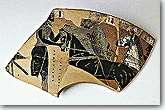During the second quarter of the 6th century B.C., one of the most prevailing shapes of Attic pottery were the "Siana Cups". Their name came from a cemetery in Rhodes and combine Corinthian iconographic elements with a linear decoration and a high stem, as it was usual at the Eastern Greece.  In their interior there is usually a tondo with human forms or animals, whereas on the exterior occasionally there are two successive zones with different themes and occasionally there is only one theme overlapping the lip and the body of the vase. Siana cups were decorated by, among others, the C Painter and the painter of Heidelberg. An excellent work from that period is the famous vase Francois, which took its name from the archaeologist who excavated it. It is a large crater with volute handles that twice bears the signature of the potter Ergotimus and the painter Kleitias. Almost all of it is decorated with mythological representations that include 270 figures and 121 inscriptions. The themes that are represented are the hunt of the Calydonian boar, funeral games in honour of the dead Patroclus, the victory dance of Theseus, the battle between the Centaurs and the Lapiths, the procession of the gods to the house of Peleus, Achilles pursuing Troilus, the return of Hephaestus to Olympus, Ajax carrying the dead Achilles and the battle between Pygmies and cranes. Its extremely rich decoration and its strictly studied composition make this vase unique. In their interior there is usually a tondo with human forms or animals, whereas on the exterior occasionally there are two successive zones with different themes and occasionally there is only one theme overlapping the lip and the body of the vase. Siana cups were decorated by, among others, the C Painter and the painter of Heidelberg. An excellent work from that period is the famous vase Francois, which took its name from the archaeologist who excavated it. It is a large crater with volute handles that twice bears the signature of the potter Ergotimus and the painter Kleitias. Almost all of it is decorated with mythological representations that include 270 figures and 121 inscriptions. The themes that are represented are the hunt of the Calydonian boar, funeral games in honour of the dead Patroclus, the victory dance of Theseus, the battle between the Centaurs and the Lapiths, the procession of the gods to the house of Peleus, Achilles pursuing Troilus, the return of Hephaestus to Olympus, Ajax carrying the dead Achilles and the battle between Pygmies and cranes. Its extremely rich decoration and its strictly studied composition make this vase unique.
Another interesting painter initially, -and potter later- was Nearchos, who was characterized by a sensitivity and love for micrographic detail. He decorated kantharoi, aryballoi and other small vases. |



















